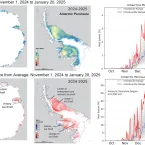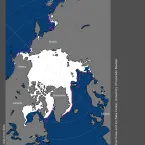Our Research
As climate changes, how do Earth's frozen areas affect our planet and impact society?
In this section
Related News & Stories
Filter by:

News Release
A new review paper, led by NSIDC senior research scientist Julienne Stroeve and published in Science on February 6, 2025, highlights the changes that will occur in the Arctic by 2100 because of global warming, and their far-reaching implications.

Analysis - Sea Ice Today
Arctic daily sea ice extent continued to hover near record daily lows in January, with the ice edge well northward of its long-term average position in most areas. In contrast to the cold conditions dominating the contiguous United States, much of the Arctic experienced above-average January temperatures. In the Antarctic, daily sea ice extent fell below the long-term average after a brief period of above-average daily extents, ending the month just above the lowest 25 percent of ice extents for the day.

Analysis - Ice Sheets Today
Surface melting for the Antarctic ice sheet appears to have set a record for the 46-year satellite observation period on January 2, 2025. All areas of the Antarctic coast that generally see significant summertime melting continue to accumulate melt days at a faster-than-average pace, except along the northern West Antarctic ice shelves, which are now near-average.

Spotlight
A new study has predicted an increase in landslide hazards in High Mountain Asia. The study authors linked higher emissions of greenhouse gases to the potential for higher risks from landslides.

Analysis - Ice Sheets Today
Widespread coastal melting occurred in Antarctica through the second half of December and is continuing in the first few days of the new year in several areas. Nearly every region with routine surface snowmelt has had more days of melt than is typical for this time of year.

Analysis - Sea Ice Today
Air temperatures in December 2024 were above average over the entire Arctic Ocean, continuing the pattern set in November. Average Arctic sea ice extent for December was the lowest in the satellite record, in considerable part due to delayed ice growth in Hudson Bay and low extent in the northern Barents Sea. Antarctic sea ice has declined at a slower-than-normal pace since mid-November, erasing the record and near-record low extents of October and November and finishing the year very close to the 1981 to 2010 average.